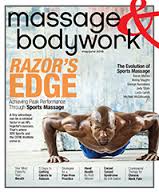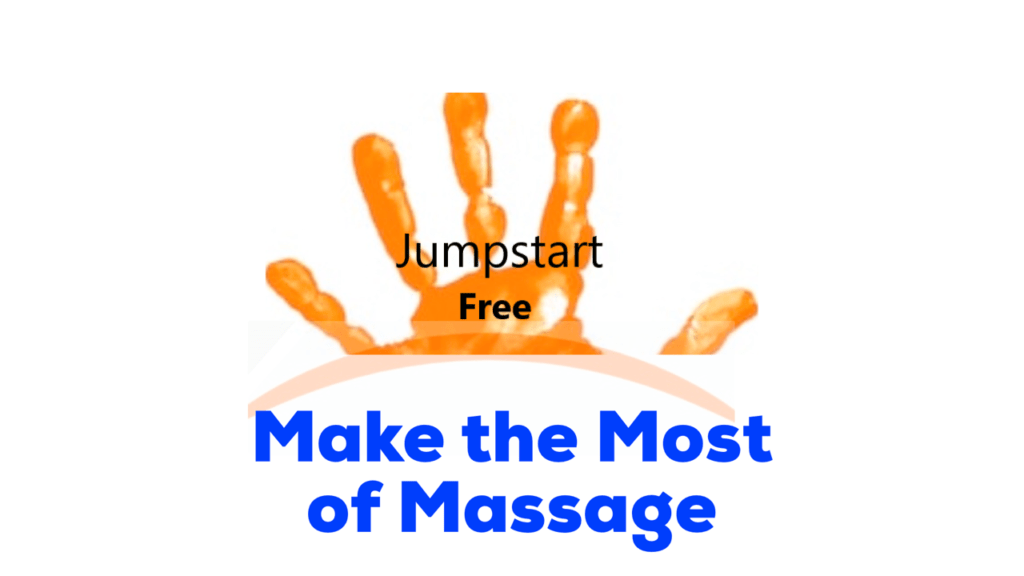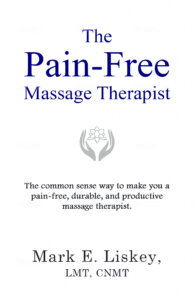How do you get new massage clients?
- Be different (not crazy different; I’ll explain).
- Find referral sources.
- Demonstrate how you’re different to the referral sources.
- Advertise how you’re different on your website.
- Advertise how you’re different on your GMB page.
- Advertise how you’re different on signs.
I know, you’ve been told to send out emails and to do health events and to hand out business cards and to join a network group and the list goes on and on.
You pick one thing and you start to do it and you don’t see any great results so you go to the next thing and it’s not much better and you keep picking things off your list until you get tired, discouraged and frustrated. Then you accept that you have and always will have a meh business or you find something else to do instead of massage.
But, honestly, what do you expect if you’re randomly picking marketing tips and don’t have a plan?
A plan has steps. A plan has goals. A plan provides opportunities where pivots can happen and a new course of action can ensue without having to start over.
Initially, a plan can seem like the long way because it requires a commitment, but ultimately randomly picking marketing tips is the long way or in some cases, the no way, because it’s a willy-nilly (half-assed) approach to growing a massage business.
The plan I outlined above has taken my meh business to a yay! business, and steps 1, 2, 3 and 5 are free (or close to free) to do. And step #4 can be done for free or for not much money.
The last step is the one that will cost some money, but you don’t need to do that one right away to have a steady stream of clients coming through your door.
So, let’s get crackin’ on this How to Get Massage Clients Plan.
How to Get Massage Clients Plan
1. Be different.
By different I don’t mean create a whole new form of massage that you can package and market.
In fact, I’m talking about something specific and not so flashy. I’m talking about differentiating yourself from the competition in relaxation and pain-relief massage.
That’s a difference, Mark?
Yes, to explain how it is a difference I need to back up first.
Tell me if I’m wrong: It’s hard to (if not impossible) to define the difference you bring to the table when you’re not sure what you do well as a massage therapist.
You may do some myofascial and reflexology and mix in some essential oils, but how do you put all of that on a website or a business card? And how does that look different than everyone else who does a lot of things?
Hey everybody, I’m the best massage therapist who combines myofascial work with reflexology and medical grade lavender oil in town.
By the way, I’m not going to tell you to whip out your credit card and get certified in a modality to standout from the crowd.
That’s not to say it wouldn’t work. That could be how you’re different if you get competent in that modality.
Actually, getting competent in one modality is what I did early on in my massage career. My specialty was neuromuscular therapy (NMT).
Back then I was all in with NMT. I subscribed to the philosophy and practiced the methodology—and it did help me build my first practice.
But as time went on I didn’t find the philosophy to be helpful or the methodology to be effective and I stopped treating clients in a NMT way.
Guess what happened to my business after I stopped practicing NMT?
It grew.
Granted, I didn’t kick all of my neuromuscular training to the curb. I kept what was helpful and discarded the rest.
For instance, I like anatomy, and NMT was big on anatomy. To this day I always show new clients the areas of concern that I addressed during the massage using my favorite text for muscle pictures—Myofascial Pain and Dysfunction (Amazon affiliate link) by Janet Travell.
But what I realized overtime as my business grew and I stopped practicing NMT was that I didn’t need any fancy credentials to bring in clients.
I just needed to give clients what they wanted. And what a majority of my clients wanted was a massage that was both (1) relaxing and (2) pain relieving at the same time.
And that is precisely the difference I’m talking about: Be the expert in the massage that is both relaxing and pain-relieving.
Okay, I think I need to address a little disappointment at this juncture. You probably were expecting something new and fancy, like a cool technique that would look great in a YouTube video—and instead you got old, boring “relaxation” and “pain relief”.
Not so sexy, I agree.
But here’s the thing, “relaxation” and “pain relief” are universal. People love to be relaxed and most everyone has a pain area.
But, Mark, is that going to be enough to bring in clients?
Yes.
And that is a confident “yes” because it has worked for me and it has worked for many massage therapists who I’ve trained for our business or who I’ve taught in our CEU classes.
Here’s how it goes down:
Your referral sources put clients on your table. Your better-than-the-competition ability to relax and provide pain-relief to your new clients brings these clients back and has them referring friends and family to you.
To up your game in pain relief massage, check this out: How to Get Good at Pain Relief Massage.
Does how you’re different have to be being good at relaxation and pain relief massage?
No.
It’s just a suggestion that is easily accessible because you’re probably already doing relaxation and pain relief massage.
If you don’t have how you’re different nailed down yet, don’t wait to figure it out before you go to step #2.
2. Find referral sources.
Why? Because the process of finding referral sources will turn the heat up for you to find what makes you different sooner than later.
Okay, here comes the bad news—finding referral sources is hard work. It requires you putting yourself out there, and sometimes that can be tough on your ego.
A while back I was determined to get a physical therapist as a referral source. I made my list of PT organizations in my area and I went to town contacting them and trying to set up an intro appointment.
I slammed up against roadblock after roadblock and it was hard not to take all this rejection personally. But finally I got a hit and I set up an appointment to do demo massages at a local PT office that was not regional or national brand.
Pay dirt.
Gold.
Can you say, I’m in the money?
One would think, but not so much.
My demo massage day was a lukewarm experience at best and when I tried to follow up, I got crickets.
Poor me, I know.
But that’s not the end of the story. Eventually, I realized that the cold call approach into the PT world was not working so I took a different tack.
When I had a client who was seeing a PT, I asked that client if I could coordinate care. All my clients said yes and once I was talking to the PT or PTA about a client’s case, I realized that I had instant credibility and an instant professional relationship with that PT or PTA—which, ultimately, resulted in unsolicited referrals.
By the way, cracking the code for referral sources is not always that hard. Personal trainers in my area responding quickly to my free demo massage offer. And one husband and wife team became a solid referral source and a true business ally.
If you’re introverted, like me, and struggle with the public side of your business, I’ve created a phone script and an email template that you can use to break the ice with potential referral sources.
You can find all that information in this free, growing a massage business program: Jumpstart.
As you start making connections, it’s then time to…
3. Demonstrate how you’re different to the referral sources.
How are you going to do that?
Demo massages.
I can explain how you can demo massages during COVID-19 in this article and yes, I said free massage.
But not free forever—just one time—and for short sessions.
Fifteen minutes for the referral sources customers/clients/patients.
Thirty minutes for the referral source and her employees.
Wait, free is bad, Mark. It cheapens my service.
Free is bad if you’re doing it all the time.
Strategic free to build a referral source base is good marketing because you’re advertising with your hands—the best tool you have for bringing in clients.
How do you go from free to your normal price?
Easy.
You say, I’m doing a free, fifteen massage.
The potential client says, Great, and gets on your chair or table.
You wow her with your work, care, concern and insights.
She says, Can I have a card?
You give her your business card.
She then asks, What’s your price?
You tell her.
Boom.
There’s no more free massage. There’s no negotiation. She got to experience your massage and if she wants to experience it again she knows it’s going to cost X number of dollars.
You reinforce that your price is your price on your website, which brings us to step #4.
4. Advertise how you’re different on your website.
Websites can be big, hairy deals or they can be little, hairy deals. I prefer the little hair deals. Haha.
Here’s how you make them little, hairy deals: First, don’t do the free website if you can spend $100 or so a year.
Free is not professional. It will have ads on it and you won’t have a domain name that you own.
I own pressureperfectmassage.com. My URL is www.pressureperfectmassage.com.
If I went for a free massage website, my URL would be a subdomain of the free massage website platform, like: www. weebly.sites,free/mark64massage.com.
Doesn’t look so professional, right? And how do you put that on a business card? So, spring for the $100-ish/year if you can.
Which website builder should I go with?
Good question.
In this article I compare 3 website builders—Weebly, Wix and Hostgator.
All three are good. I give you the short version of my comparison in the opening paragraph.
If you’re looking to have a blog or are going to have more than one website and are willing to invest some time into learning a platform, I would recommend a WordPress website.
WordPress is free. You will pick a theme (website design) for your WordPress site. Some themes cost money. Some are free.
You can also add or change functionality on your WordPress website using plugins. As in the case with themes, some are free and some cost money.
In a minute I’m going to direct you to my Build a Massage Website (For Non-Techies) that will help you create a professional-looking, 3-page website on WordPress and other website platforms.
But before I do I want to circle back to advertising your difference on your website. It will be important for you to show what sets you apart from the competition on your Home and your About page.
Our difference is that we’re not a cookie cutter massage spa.
We emphasize customer care and our experience.
Here’s our Home and About pages.
If you’re in the process of figuring out how you’re different, I have this article for you: How to Write an About Page. In the article I show you how to figure out your unique story.
And in How to Write a Homepage I provide ways for you to create a Homepage that will help you stand out from the crowd.
Links to these articles can be found in my How to Build a Website Guide (For Non-Techies). The Guide is comprehensive, so if you only want help with your Home and/or About pages, just click on the articles above.
One last thing about websites, don’t get lost in the sauce. In other words, keep it simple and don’t try to make it perfect, especially when it comes to the design. Instead, focus your efforts on the content—make the words and videos ring true to how you’re different.
For example, we have many years of massage experience and expertise in our company, so on our website I’m going to demonstrate that by providing instructional massage videos to clients and potential clients.
Here’s one:
Does the video have to be perfect?
Hellz no.
People will overlook the homemade nature of a video if the content of the video is helpful and/informative.
The video is one of many pieces of information on the website that helps to demonstrate that we are what I say we are—experienced massage therapists with expertise.
And no you don’t need a video on your website to have an effective website. If it’s in your wheelhouse, go for it. If it’s too much of a stretch now, save if for another day.
Remember, simple.
An engaging, 3-page website—Home/About/Services—will do the trick.
Once you have a website, it’s time to…
5. Advertise how you’re different on your Google My Business (GMB) page.
What exactly is Google My Business?
“Google My Business is a free and easy-to-use tool for businesses and organizations to manage their online presence across Google, including Search and Maps,” says Google. “If you verify and edit your business information, you can both help customers find your business and tell them your story.”
Mark says, turn on your computer. Google “massage near me”. The first thing that comes up is probably an ad(s). Then under that is a local search with massage businesses in the area. Right now (Google changes things around often) that local search has a map with 3 businesses underneath it and a “More Businesses” button is underneath that.
Google My Business is the way to input your business’s information so your business appears in the local search. Do the basics and you’ll get basic results. Do more than your competition and you can potentially climb higher on the local search page.
If you’re still wondering if this is a good time investment here are some stats from Hubspot that may help you decide.
Over 2 years there has been a 900% increase in “near me” or “close by” searches.
72% of consumers that did a local search visited a business within a 5 mile radius.
46% of all Google searches are looking for Local information.
Here’s how you get started with your GMB page.
From the get-go I want you to follow this one rule when inputting business information to GMB:
* Be consistent with Name, Address and Phone Number (NAP).
Your GMB NAP must match your website NAP.
Google is cross-referencing NAP. If your NAP is not exactly the same on both, it will screw up the local search results. So, it’s important that you take your time and make sure that your website NAP is the same as your GMB NAP.
Okay, onto your GMB page. For now, I’m going to show you the basic GMB registration and a couple of key optimization steps—because I want to spend most of the time showing you how I advertise my difference on my GMB page. If you want more tips for optimizing your GMB page, go here.
If you’ve never registered or claimed your business with GMB do this:
(1) CLAIM YOUR BUSINESS or go to GMB to register your business.
Here’s the thing, you may have never registered your business, but your business may already be tagged with GMB without you knowing it. Big brother Google does this. So, if you’ve never registered your business with GMB, first do a Google search to see if your business comes up in the local search.
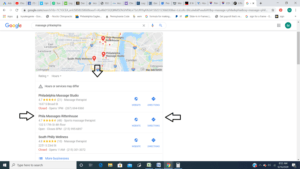
If your business comes up, click on your name. A GMB box should appear with your business’s info in it. Scroll down until you see “Own this business?”. Click on that and go through the steps to claim the business. It’s not complicated.
If you don’t see your business in the local search then you’re going to have to register your business with Google. To do that, you’re going to:
(a) Sign in to your Gmail Account.
(b) Open Google My Business page.
(c) Follow steps to register a business.
Once registered you can start to input your business information.
*Later on whenever you want to get into your GMB account you can access it through this link: https://business.google.com/
Next…
(2) Pick the BEST CATEGORY that represents what you do.
Not sure which one to pick, then look to see what your competitors are doing.
Click on a competitor’s GMB listing and look right under their business name.
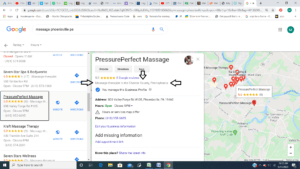
Add secondary categories by clicking on Additional Categories under Primary Categories. Just start typing in the box until your category comes up, like Sports Massage.
(3) Input ADDRESS and make sure it matches website address!
This step is important because if the address on your website doesn’t exactly match your business address, you won’t rank. So, take your time to be accurate and consistent with your name, address and phone number (NAP).
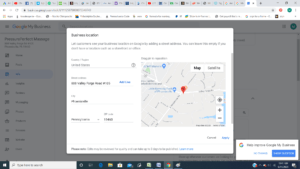
(4) Fill out SERVICE AREA.
When I first filled out Service Area for PressurePerfect Massage, I forgot to click on the Apply button and for years Google never 100% knew the area my business covered. Again it pays to go slow and make sure you do things correctly the first time.
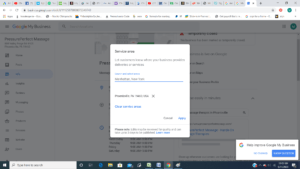
(5) Fill out HOURS.
Make sure website hours match GMB hours. If your hours change on your website make sure you change them on your GMB page.
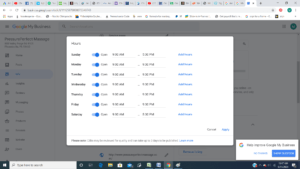
Under HOURS is MORE HOURS where you can add hours for specific services or specials.
Going forward it’s important to keep your hours updated and remember to add special hours for holidays.
Okay, like I said before, go here for more GMB optimization tips, but for now I want to show you how I show my difference on my GMB page.
Show How You’re Different on Your GMB Page
Here’s the first way: I show it on our GMB posts.
Take a look.
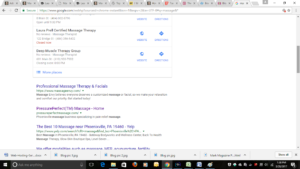
The first post on the left helps establish me as being competent at relaxation and pain relief massage. The post next to it talks about our Covid-19 safety measures which shows that we care about our clients/potential clients and their safety.
How do you add a post to your GMB page?
Before you add, let’s talk about the type of post Google allows.
A GMB post can be an Information (Update), Event or an Offer post.
An Information post lasts for 7 days before Google removes it.
An Offer post lasts as long as the offer is valid.
An Event post lasts until the event takes place.
Okay, so, where do you write a post?
Click on Posts in the side panel.
Then click on the Update button (even if you have not written the post; I know, that’s a little confusing) to write an Information post.
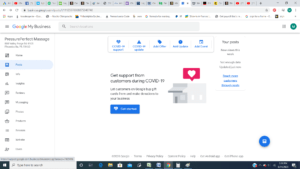
I write in Word and then copy and paste into GMB posts.
What can you write about?
Information relevant to a potential client, like massage research, a massage tip, or wellness information related to massage—but make sure it’s connected to what you do in a massage (how you’re different).
For example, if you use essential oils in your massage you can talk about the potential benefits of a particular essential oil, but don’t stop there. Also explain how you incorporate that particular essential oil into a massage (that’s what makes you different).
GMB also lets you put short videos on your GMB page. So, you could also demonstrate your application of that particular essential oil.
Does that make sense?
Choose a topic that reflects something that you do in massage and connects to your massage experience or massage expertise (how you’re different).
Does how you’re different have to be a big, hairy deal on your GMB page?
No.
Why?
Because a viewer of you GMB page isn’t comparing you head-to-head with your competition on that particular topic.
If you write a post about focused pressure versus broad pressure, the potential customer is not comparing your post with other massage therapists who write about pressure.
The viewer is just trying to determine if what you offer is what he wants. So after reading your post about focused pressure versus broad pressure, the viewer may think something like this: Sabine knows her stuff about pressure.
To get him to think about you being the best person to deliver the perfect pressure to help him with his shoulder knot, you have to connect yourself to the post.
In the case of focused pressure versus broad pressure, the connection in the post might be: This is my favorite massage tool to deliver focused pressure in the shoulders and neck. It allows me to easily pinpoint tight and tender areas at the top of the shoulders.
You’re not saying outwardly: Hey, look at me! I’m an expert with pressure. Instead you’re providing details (specific pieces of information) about your work that demonstrate you’re an expert with pressure
So, from reading the post the potential customer knows that you’re experienced and probably competent with pressure. He also knows how you’re different: You use massage tools which allows you to pinpoint the pressure.
That said, don’t over-think your post.
Focus on one thing with each post.
For my business, I’m going to write posts about COVID-19 safety and pain relief/relaxation massage. And I will connect each post to me.
Here’s a list of potential topics for me and how they can connect back to me.
- Air exchange in the massage room.
Connection: From the research that I did, I found that…
- Why I look Hazmat-y in the massage room.
Connection: I’m doing total PPE to protect you.
- Temperature checks.
Connection: We follow CDC guidelines and do temperature checks as a safety measure.
- One therapist and one client in the office at a time.
Connection: We go above and beyond to keep you as safe as possible.
- Relaxation and pain relief in the same massage.
Connection: We offer a massage that is both relaxing and pain relieving.
- Focused pressure versus broad pressure.
Connection: Here’s how I do broad pressure and here’s how I do focused pressure.
- Focused ischemic compression for tibialis posterior tendonitis.
Connection: Runners, I have a tib posterior massage for you.
You get the idea, right?
Other GMB Housekeeping Details
You can also add a COVID-19 Update. I like that feature and have been using that a lot during the pandemic.
If you want to add event post click on Add Event at the top of the post page. And if you want to add an offer post click on Add Offer at the top of the post page.
Lastly, I need to mention keywords.
You don’t need any SEO superpowers to choose your keywords.
Keep keywords simple and they should be the same keywords you used in your description and other areas: location, “massage” and type of massage you want to promote (if/when appropriate).
GMB posts done.
So far with the steps I’ve shown you there’s not a lot (if any) money that needs to go down to get clients walking through your door. The last step in this plan requires a little cash out—not crazy cash out, just some.
6. Put how you’re different on signs.
Signs bring in clients.
My first serious sign was a huge, OBNOXIOUS banner-sign at the front of a shopping center.
At the time, I had an office in a fitness center. The fitness center owner and I went in on a ginormous, yellow banner-sign with red lettering that said MASSAGE AT THE EDGE 610-935-5902.
The phone number was my office number (pre-cell), so all the calls were coming directly to me.
The sign was a fantastic success. I got newbies and some converted to repeats, but there was only one problem. The sign went against township code and the code officer, who was friends with my client/friend, told me, through my client/friend, to take the sign down.
Okay, so it wasn’t a total, slam dunk advertising story, but I completely took advantage of my client/friend’s relationship with the code officer, and I dragged my feet about taking the sign down and was able to squeeze out a few more months of killer advertising.
A more recent example of signs success happened at Phoenixville office. Our Phoenixville office is at a corner light with high traffic volume and our banner sign has great visibility.

The wind does beat the caca out our banner sign, and I have to replace it about once every 18 months, but that’s chump change when compared to all the new clients it has netted us.
Outside signs work. If you have an opportunity to put one up, do it.
If you don’t, think outside the box. How about a sign on your car?
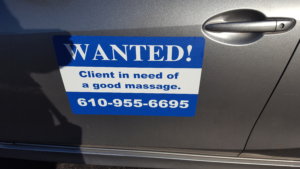
If your car is strategically parked in your work parking lot it connects your massage office with your business location.
By the way, besides bringing in more clients, a sign can also give you an emotional boost.
How?
Your sign is not only letting the world know that you’re here, it’s also letting you know that. So, every time you go to your office and you see your sign, you’re telling yourself that you’ve arrived. That can be motivating and uplifting.
We talked about the importance of signage, but what type of sign should you put up?
A sign that people notice.
Sign Types
The obnoxious one I had by the road at the shopping center was perfect for getting the attention of drivers.
But an obnoxious one at the corner of our current Phoenixville office is overkill and inappropriate.
Why?
The Phoenixville office is at intersection with a light. Cars are stopped at the light and have a chance to look around. Our sign doesn’t need to be screaming at them.
Also, since our business name is on the sign I don’t want our business name to be associated with obnoxious. The obnoxious banner sign at the shopping center just said MASSAGE.
Speaking of banner signs, your sign does not have to be a banner sign to be successful.
This A-frame that is also up at our Phoenixville office allows us to change our messaging and drives business though our door.
I have to admit that I was opposed to this A-frame sign initially. My wife, Lisa, bartered with a chiro in the area—massage for referrals and whatever else the chiro wanted to throw in. An A-frame sign was part of the deal. You probably saw it in the banner sign pic above.

I hated this A-frame sign because it required more work than the banner sign. And I bitched to Lisa about how dumb that sign was and how she got screwed in the deal.
Well, at one point when business was slow I decided to drag out that clunky, stupid A-frame sign and clean it up.
Then I put the pain relief pitch on it, instead of repeating our intro offer which was on the banner sign.
At the end of the day, two signs with two messages that show how we’re different from the competition produced more call-ins than one sign.
I love our stupid, clunky A-frame now and I’ve apologized to Lisa for bad mouthing her barter deal.
So, pain-relief and our intro special is what I put on our signs. What should you put on your sign?
Your Sign Message (Difference)
How you’re different may be different than how I’m different.
Again, what makes us different is our intro special. Another difference is that we do pain relief massage.
Remember, what makes you different from the competition doesn’t have to be earth shattering and space is limited on a sign.
If you’re stuck just go with price and what type of massage you do.
The potential client can always go to your website or GMB page to get more details.
For example, Tasha sees our sign for pain relief massage. She’s intrigued so she goes to our website and then reads this video blog post about pain relief massage. Sign gets her intention and the website gets her to call. Boom.
Speaking of getting calls, don’t forget to put your phone number and/or website on the sign.
Where Do You Get a Sign?
You can get a sign online or at a local sign shop.
Banner signs done online are usually cheap and fairly easy to design yourself.
When I have sign that really needs to be spec-ed out and I need some design input, I go to a local sign store. Some local sign stores have been great. Others have been bad. Ask other business allies where they get their signs done to make sure you find the one that works for you.
We’re through the plan. Let’s reccap.
How to Get Massage Clients in a Nutshell
Getting massage clients isn’t brain surgery, but it’s also not sheer luck. You can dink and dunk down the field, selecting marketing tips that may or may not be right for you, and spend unnecessary years building your business or you could follow a proven plan.
This is the plan that has taken my meh business to a yay! business:
- Be different.
Articulate what makes you different from your competition. It doesn’t have to be something extraordinary. A special intro price could be it.
2. Find referral sources.
Establish relationships with other businesses that can send you referrals.
3. Demonstrate how you’re different to the referral sources.
Show your referral sources how you are different from the competition. Demo massages are a free and easy way to do that.
4. Advertise how you’re different on your website.
Start to make your marketing consistent across all media by stating how you’re different on your website.
5. Advertise how you’re different on your GMB page.
Rinse and repeat on your GMB page.
6. Put how you’re different on signs.
Be bold. Don’t back away from declaring how you’re different on signage.
You’ve read this article so pat yourself on the back, but don’t take your foot off the accelerator. Put the work in now, create the business you want and once you do then you can go on maintenance mode.
How to Keep Your Foot on the Accelerator
If you’re just starting your massage business, this free course that is designed to get you to 30K: Jumpstart.
To take your massage business to the next level, go here: The Accelerator.
Ways to Save Money and Build Your Practice:
Massage Insurance: Who has the Cheapest Massage Insurance
Website: Cheapest Way to Build a Website.
Rent a Massage Room: How to Rent a Massage Room for Cheap.
Questions?
I am here. Email me a mark@makethemostofmassage.com!



